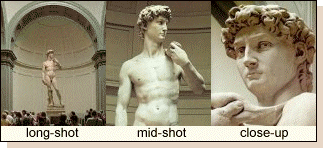Lesson 10: Modes of Address
Directness and formality
Modes of address also differ in their directness (Tolson 1996, 56-65). In linguistic codes, this is related to whether 'you' are explicitly addressed, which in literary modes is quite rare.
In representational visual codes directness is related to whether or not a depicted person appears to look directly at the viewer (in the case of television, film and photography, via the camera lens).
A direct gaze simulates interaction with each individual viewer (an impossibility, of course, outside one-to-one communicative media, but a feature of 'cam-to-cam' communication on the internet or in video-conferences).
In film and television, directness of address is reflected in linguistic codes as well as camerawork.
Indirect address is the principal mode employed in conventional narrative, masking authorial agency in the interests of foregrounding the story. Conventional film and television drama depends on 'the illusion that the represented participants do not know they are being looked at, and in which the represented participants must pretend that they are not being watched' (Kress & van Leeuwen 1996, 126).
Class assignment 1 (group work, done orally):
Read the quotation below and try to explain the reasons for this kind of mode of address constraints.
"In television programmes, a direct mode of address is largely confined to newsreaders, weather forecasters, presenters and interviewers - which is why it seems so strange on the rare occasions when we notice an interviewee glancing at the camera lens. In short, people from outside the television industry are seldom allowed to talk to us directly on television."
Chandler, Daniel. Semiotics for Beginners.
Class assignment 2 (group work, done orally):

Comment upon the effect produced by the degree of directness displayed by this poster.
Think of the possible explanation of its popularity, which eventually resulted in creating the well-known entry "§ 154. Ты нарисовал плакат с пальцем? Артемий Лебедев" http://www.artlebedev.ru/kovodstvo/sections/154/
Consider the effect produced by a more recent poster
The mode of address varies in its formality or social distance.
Kress and van Leeuwen distinguish between 'intimate', 'personal', 'social' and 'public' (or 'impersonal') modes of address (Kress & van Leeuwen 1996, 130-135).
In relation to language, formality is quite closely tied to explicitness, so that intimate language tends to be minimally explicit and maximally dependent on non-verbal cues, whilst public language tends to reverse these features (especially in print).
Class assignment 3 (group work, done orally):
Discuss issues of social distance expressed by means of visual representation. Use the picture below as a possible example.

|
Resources for Lesson 10:
Chandler, Daniel. Semiotics for Beginners.
Alberti, Leon Battista (1966): On Painting (trans. John R Spencer). New Haven, CT: Yale University Press
Wright, Lawrence (1983): Perspective in Perspective. London: Routledge & Kegan Paul
Romanyshyn, Robert D (1989): Technology as Symptom and Dream. London: Routledge
Foucault, Michel (1970): The Order of Things. London: Tavistock
Peirce, Charles Sanders (1931-58): Collected Writings (8 Vols.). (Ed. Charles Hartshorne, Paul Weiss & Arthur W Burks). Cambridge, MA: Harvard University Press
Johnson, Richard (1996): 'What is Cultural Studies Anyway?'. In Storey (Ed.) op. cit., pp. 75-114
MacCabe, Colin (1974): 'Realism and the Cinema', Screen 15(2), pp. 7-27
Althusser, Louis (1971): Lenin and Philosophy (trans. Ben Brewster). London: New Left Books
Booth, Wayne C ([1961] 1983): The Rhetoric of Fiction (2nd Edn.). Chicago, IL: Chicago University Press
Kress, Gunther & Theo van Leeuwen (1996): Reading Images: The Grammar of Visual Design. London: Routledge
Tolson, Andrew (1996): Mediations: Text and Discourse in Media Studies. London: Arnold
http://www.rrrrrrrr.ru/img/7809.jpg
|
Пермский государственный университет
|